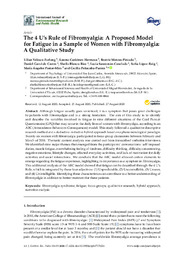Por favor, use este identificador para citar o enlazar este ítem:
https://hdl.handle.net/11000/33509Registro completo de metadatos
| Campo DC | Valor | Lengua/Idioma |
|---|---|---|
| dc.contributor.author | Velasco-Furlong, Lilian | - |
| dc.contributor.author | Gutiérrez, Lorena | - |
| dc.contributor.author | Mateos-Pintado, Beatriz | - |
| dc.contributor.author | Garvi, Daniel | - |
| dc.contributor.author | Blanco-Rico, Sheila | - |
| dc.contributor.author | Sanromán-Canelada, Lucía | - |
| dc.contributor.author | López Roig, Sofía | - |
| dc.contributor.author | Pastor-Mira, María-Ángeles | - |
| dc.contributor.author | Peñacoba, Cecilia | - |
| dc.contributor.other | Departamentos de la UMH::Ciencias del Comportamiento y salud | es_ES |
| dc.date.accessioned | 2024-10-16T08:49:39Z | - |
| dc.date.available | 2024-10-16T08:49:39Z | - |
| dc.date.created | 2020-08-27 | - |
| dc.identifier.citation | International Journal of Environmental Research and Public Health 2020, 17 | es_ES |
| dc.identifier.issn | 1660-4601 | - |
| dc.identifier.issn | 1661-7827 | - |
| dc.identifier.uri | https://hdl.handle.net/11000/33509 | - |
| dc.description.abstract | Although fatigue usually goes unnoticed, it is a symptom that poses great challenges to patients with fibromyalgia and is a strong limitation. The aim of this study is to identify and describe the variables involved in fatigue in nine different situations of the Goal Pursuit Questionnaire (GPQ) that may occur in the daily lives of women with fibromyalgia, according to an ABC (Antecedents–Behaviors–Consequences) model. This study followed a qualitative descriptive research method and a deductive–inductive hybrid approach based on a phenomenological paradigm. Twenty-six women with fibromyalgia participated in focus group discussions between February and March of 2018. Thematic content analysis was carried out from transcribed verbatim interviews. We identified nine major themes that emerged from the participants’ conversations: self-imposed duties, muscle fatigue, overwhelming feeling of tiredness, difficulty thinking, difficulty concentrating, negative emotions, lifestyle changes, affected everyday activities, and lack of motivation for daily activities and social interactions. We conclude that the ABC model allowed certain elements to emerge regarding the fatigue experience, highlighting its importance as a symptom in fibromyalgia. This additional analysis of the ABC model showed that fatigue can be described through the 4 U’s Rule, which is integrated by these four adjectives: (1) Unpredictable, (2) Uncontrollable, (3) Unseen, and (4) Unintelligible. Identifying these characteristics can contribute to a better understanding of fibromyalgia in addition to better treatment for these patients. | es_ES |
| dc.format | application/pdf | es_ES |
| dc.format.extent | 23 | es_ES |
| dc.language.iso | eng | es_ES |
| dc.publisher | MDPI | es_ES |
| dc.rights | info:eu-repo/semantics/openAccess | es_ES |
| dc.rights | Attribution-NonCommercial-NoDerivatives 4.0 Internacional | * |
| dc.rights.uri | http://creativecommons.org/licenses/by-nc-nd/4.0/ | * |
| dc.subject | fibromyalgia syndrome | es_ES |
| dc.subject | fatigue | es_ES |
| dc.subject | focus groups | es_ES |
| dc.subject | qualitative research | es_ES |
| dc.subject | hybrid approach | es_ES |
| dc.subject | narrative analysis | es_ES |
| dc.subject.other | CDU::1 - Filosofía y psicología::159.9 - Psicología | es_ES |
| dc.title | The 4 U’s Rule of Fibromyalgia: A Proposed Model for Fatigue in a Sample of Women with Fibromyalgia: A Qualitative Study | es_ES |
| dc.type | info:eu-repo/semantics/article | es_ES |
| dc.relation.publisherversion | https://doi.org/10.3390/ijerph17176224 | es_ES |

Ver/Abrir:
2020 Velasco et al the 4 Us ijerph-17-06224 PUBLICADO.pdf
389,25 kB
Adobe PDF
Compartir:
 La licencia se describe como: Atribución-NonComercial-NoDerivada 4.0 Internacional.
La licencia se describe como: Atribución-NonComercial-NoDerivada 4.0 Internacional.
.png)